Preoperative Systemic Therapy for Breast Cancer
Marc E. Lippman
Preoperative (or neoadjuvant) systemic therapy for breast cancer is a rapidly changing field with complex issues surrounding appropriate patient selection, management, and research considerations. Unquestionably, patients require coordinated multidisciplinary care with input from radiologists, surgeons, radiation oncologists, and medical oncologists for optimal outcomes.
Substantial data do not exist suggesting that preoperative therapy has superior survival to postoperative systemic therapy, but there are other potential benefits for the patient. Preoperative systemic therapy is indicated for patients with locally advanced breast cancer—T4 tumors or N2 or N3 nodal disease—to convert them to operable. While not formally demonstrated in randomized clinical trials, survival rates for locally advanced breast cancer have increased substantially with preoperative systemic therapy. For patients with unicentric cancers, which are too large relative to the size of the breast to allow cosmetically acceptable breast-conserving surgery (BCS), preoperative chemotherapy will allow BCS in at least one-third of these patients. The lack of reliable methods for evaluating the extent of residual disease in the breast after preoperative chemotherapy remains an obstacle to increasing rates of BCS, even as pathologic complete responses to newer drug combinations and targeted therapy become more frequent. In patients with clinically negative nodes at presentation, sentinel node biopsy after chemotherapy accurately stages the axilla, and this approach has been shown in randomized trials to decrease the need for axillary dissection. There is more controversy regarding the management of patients who present with clinical nodal metastases that appear to resolve with preoperative chemotherapy. Two recent prospective trials investigating the accuracy of sentinel node biopsy in this setting (1, 2) reported false negative rates of 18% to 21% with the removal of 2 sentinel nodes. False negative rates decreased below the 10% threshold if 3 or more nodes were removed, but the median number of sentinel nodes identified in large multicenter trials of sentinel node biopsy prior to chemotherapy is 2. At the present time, axillary dissection remains the standard management for patients presenting with clinically involved (and histologically confirmed) nodal metastases, pending the results of additional trials discussed below. Outside of clinical trials, there is little justification for preoperative systemic therapy for tumors suitable for management by established means of breast conservation with appropriately administered systemic adjuvant therapy or in patients who require mastectomy due to multicentric disease. In fact, optimal guidelines for postoperative radiation therapy, which are reasonably well established for breast cancers managed by surgery first, are far less clear for patients staged after the completion of preoperative systemic therapy and are the subject of intense investigation. Particularly unclear at this time are optimal recommendations for treatment of clinically or pathologically positive nodes that become either clinically negative or pathologically negative after preoperative systemic therapy. In general, there is wide agreement that radiation therapy is required for essentially all patients rendered operable and downstaged by systemic therapy; however, there remains a substantial lack of clarity of how best to treat formerly involved lymph node areas. A major potential advantage of using neoadjuvant systemic treatments would be to permit the tailoring of local-regional treatment recommendations based on disease response. Specifically, based on the data available to date, it is reasonable to ask whether patients with a very favorable response could potentially avoid the toxicities of more aggressive local-regional therapies. Two recently activated phase III trials investigate this concept; one with respect to axillary management and one with respect to avoidance of postmastectomy or regional lymph node radiation.
Stay updated, free articles. Join our Telegram channel

Full access? Get Clinical Tree







